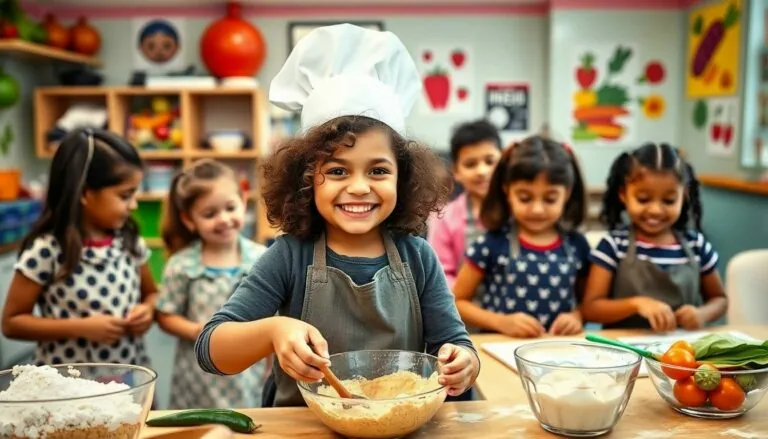Looking for a birthday party idea that’s both fun and educational? A kids’ cooking class party combines the excitement of hands-on food preparation with the joy of celebration. Instead of traditional party games youngsters can roll up their sleeves and become mini chefs for the day.
These unique parties transform ordinary kitchen activities into extraordinary memories. Children learn basic cooking skills while creating delicious treats they can enjoy with their friends. From decorating cupcakes to making pizza from scratch the possibilities are endless. Plus parents love that their kids are learning valuable life skills while having a blast at the same time.
Table of Contents
ToggleWhy Choose a Cooking Class Birthday Party
A cooking class birthday party creates a unique hands-on experience that engages children in active learning. Children develop essential life skills through measuring ingredients, following recipes, and understanding kitchen safety protocols. The interactive format encourages social interaction among party guests as they work together to create delicious treats.
Educational benefits extend beyond basic cooking skills:
- Learning fundamental math concepts through measuring ingredients
- Developing fine motor skills while mixing, kneading, and decorating
- Understanding kitchen safety and proper food handling techniques
- Building confidence through completing culinary tasks
Practical advantages make cooking parties an appealing choice:
- Built-in entertainment eliminates the need for additional activities
- Each child takes home their culinary creations as party favors
- Professional instructors handle setup, supervision, and cleanup
- Parents receive photos of memorable cooking moments
The structured environment offers multiple benefits:
- Small groups ensure individual attention from instructors
- Step-by-step guidance keeps children focused and engaged
- Age-appropriate recipes match skill levels
- Clean, professional kitchen spaces provide safe learning areas
| Party Element | Traditional Party | Cooking Class Party |
|---|---|---|
| Duration | 2-3 hours | 2-3 hours |
| Activities | 1-2 games | 3-4 cooking projects |
| Take-home Items | Party bags | Self-made treats |
| Learning Value | Limited | High |
| Adult Supervision | Parent-led | Professional instruction |
This party format accommodates dietary restrictions through recipe modifications while maintaining an inclusive atmosphere for all participants. Children gain practical knowledge in a festive setting that transforms ordinary kitchen tasks into extraordinary birthday memories.
Planning Your Child’s Culinary Celebration
A successful kids’ cooking class birthday party requires strategic planning for menu timing age group coordination. The following guidelines ensure a smooth celebration that engages young chefs while maintaining safety standards.
Age-Appropriate Menu Selection
The menu selection varies based on the age group attending the cooking party. Children ages 4-6 excel with simple recipes like decorated sugar cookies fruit kebabs mini pizzas. Ages 7-9 handle more complex tasks such as sandwich assembly pasta making cupcake decorating. Older kids ages 10-12 manage advanced recipes including homemade sushi basic sauces layered desserts.
| Age Group | Recommended Recipes | Skill Level |
|---|---|---|
| 4-6 years | Sugar cookies, Fruit kebabs | Basic |
| 7-9 years | Sandwiches, Cupcakes | Intermediate |
| 10-12 years | Sushi, Layer cakes | Advanced |
Party Duration and Group Size
The optimal party duration spans 2-3 hours allowing time for instruction cooking cleanup. Small groups of 6-8 children create an ideal learning environment for ages 4-6. Medium groups of 8-10 work best for ages 7-9. Larger groups of 10-12 suit older children with more cooking experience.
| Group Type | Number of Children | Recommended Duration |
|---|---|---|
| Small | 6-8 children | 2 hours |
| Medium | 8-10 children | 2.5 hours |
| Large | 10-12 children | 3 hours |
Essential Equipment and Safety Measures
A kids’ cooking class birthday party requires specific equipment and safety protocols to create a secure learning environment. Proper preparation of tools and implementation of safety guidelines ensures children can explore cooking activities with confidence.
Kitchen Safety Guidelines
- Store sharp utensils in designated areas away from children’s reach
- Position cooking stations at appropriate heights for young participants
- Set clear boundaries around hot surfaces or equipment
- Establish handwashing stations with antibacterial soap and paper towels
- Create a first aid station equipped with basic medical supplies
- Maintain clear paths between cooking stations to prevent accidents
- Designate specific areas for handling raw ingredients
- Install fire extinguishers in accessible locations
- Keep cleaning supplies separate from food preparation areas
- Ensure proper ventilation throughout the cooking space
Required Tools and Supplies
- Child-safe knives with rounded tips
- Non-slip cutting boards in multiple colors
- Measuring cups and spoons in various sizes
- Heat-resistant mixing bowls
- Disposable aprons and chef hats
- Sanitized cooking utensils for each participant
- Step stools with non-slip surfaces
- Recipe cards with large print text
- Food storage containers for take-home treats
- Temperature-safe mixing spoons
- Disposable gloves in children’s sizes
- Color-coded preparation containers
- Timer clocks with large displays
- Easy-grip vegetable peelers
- Clean-up supplies including sanitizing wipes
Popular Recipe Ideas for Kids’ Parties
Kid-friendly recipes combine fun presentation with simple preparation techniques. These recipes provide opportunities for children to measure ingredients, mix components, and create edible masterpieces.
Sweet Treat Favorites
Kids create decorated sugar cookies using cookie cutters, colorful frosting, and edible sprinkles. Rainbow fruit skewers feature fresh strawberries, pineapples, grapes, and oranges arranged in vibrant patterns. Chocolate-dipped pretzel rods transform into magic wands with candy toppings and sparkly sugar. Mini cupcake stations let children pipe frosting designs and add custom decorations. Rice crispy treats become moldable edible clay for creating 3D shapes and figures. No-bake cookies combine oats, cocoa, and peanut butter into quick treats that kids mix themselves. Yogurt parfaits layer granola, berries, and honey into colorful edible art.
Savory Cooking Projects
Pizza-making stations enable kids to roll dough, spread sauce, and choose toppings. Mini quesadillas fold cheese, vegetables, and protein between tortillas for easy assembly. Homemade spring rolls wrap rice paper around fresh vegetables, noodles, and herbs. Sandwich sushi rolls combine bread, cream cheese, and vegetables into spiral creations. Build-your-own taco bars feature soft shells, seasoned protein, cheese, and fresh toppings. Mini slider stations let kids form patties, add cheese, and stack ingredients. Veggie boats hollow cucumber, zucchini, or pepper shells for filling with healthy dips.
Party Decorations and Theme Integration
Transforming the party space into a professional cooking environment creates an immersive experience for young chefs. The right decorations enhance the culinary atmosphere while maintaining safety standards.
Kitchen-Inspired Décor
Chef hats rest at each cooking station alongside personalized aprons featuring each child’s name. Red gingham tablecloths cover workspace tables paired with coordinating napkins in cooking-themed patterns. Hanging utensil-shaped banners display messages like “Chef’s Kitchen” or “Birthday Baker.” Balloon bouquets incorporate metallic silver balloons shaped like kitchen tools mixed with solid colors matching the party theme. Paper chef toques serve as centerpieces filled with artificial fruits vegetables.
Take-Home Party Favors
Mini rolling pins wrapped in cellophane come with recipe cards for recreating party treats. Cookie cutters packaged in mesh bags feature seasonal shapes matching party recipes. Decorated wooden spoons paired with kid-sized measuring cups encourage continued cooking exploration. Silicon spatulas feature custom “Junior Chef” labels alongside miniature whisk attachments. Recipe box sets include basic kitchen safety cards measuring conversions party recipes. Each favor bag contains an official “Junior Chef Certificate” personalizing the cooking class experience.
Managing Food Allergies and Dietary Restrictions
Food allergies affect 1 in 13 children, making safety protocols essential for cooking class birthday parties. Party hosts collect detailed allergy information from parents during the invitation process through digital forms or paper questionnaires.
Common food allergens to monitor include:
- Peanuts in baking ingredients
- Tree nuts in garnishes
- Dairy products in recipes
- Eggs in baking mixes
- Wheat in flour based items
- Soy in processed foods
- Shellfish in seafood dishes
Cross contamination prevention strategies include:
- Designating separate preparation areas for allergen free foods
- Using color coded utensils for different dietary needs
- Maintaining distinct ingredient stations
- Sanitizing surfaces between activities
| Dietary Restriction | Alternative Ingredients |
|---|---|
| Gluten Free | Almond flour, rice flour |
| Dairy Free | Coconut milk, almond milk |
| Egg Free | Applesauce, flax eggs |
| Nut Free | Sunflower seeds, pumpkin seeds |
| Vegan | Plant based substitutes |
Recipe modifications accommodate various dietary needs without compromising the fun experience. Party hosts label all ingredients clearly using printed cards at each cooking station. Instructors receive specific training on handling food allergies during children’s cooking classes.
Alternative menu options include:
- Gluten free pizza with cauliflower crust
- Dairy free chocolate cupcakes
- Egg free sugar cookies
- Nut free energy balls
- Vegan fruit parfaits
- Posted allergy action plans
- Accessible emergency contacts
- First aid supplies
- Staff trained in allergy response
- Clear evacuation routes
Entertainment Beyond Cooking
Interactive games enhance the cooking party experience through culinary-themed activities between recipe preparations. Kids participate in food-related word games like “Ingredient I Spy” or “Kitchen Equipment Charades” during mixing cooling periods.
Games integrate seamlessly with cooking activities:
- Memory matching with recipe cards identifying ingredients pictures
- Musical mixing bowls where kids rotate stations when music stops
- Taste test challenges identifying mystery ingredients blindfolded
- Food trivia competitions testing kitchen knowledge
- Scavenger hunts locating cooking tools around the kitchen
Creative activities complement the cooking experience:
- Decorating personalized chef hats with fabric markers
- Creating recipe cards with colorful designs
- Customizing aprons with food-themed stamps
- Drawing dream restaurant menus
- Crafting ingredient collages from magazines
Movement activities keep energy levels balanced:
- “Hot Potato” passing using oven mitts
- “Freeze Dance” with wooden spoon microphones
- “Simon Says” incorporating cooking motions
- “Follow the Chef” movement games
- “Kitchen Equipment Orchestra” using tools as instruments
Engaging entertainment options maintain excitement when recipes require cooling or baking time. These activities reinforce cooking concepts while providing structured breaks from food preparation. Each activity accommodates different age groups through modified rules complexity levels.
| Age Group | Recommended Activities | Duration |
|---|---|---|
| 4-6 years | Simple games movement based | 10-15 min |
| 7-9 years | Creative craft projects | 15-20 min |
| 10-12 years | Skill based challenges | 20-25 min |
Conclusion
A kids’ cooking class birthday party offers the perfect blend of entertainment education and lasting memories. Children don’t just leave with full bellies – they gain valuable life skills confidence and a newfound appreciation for culinary arts. The combination of hands-on learning kitchen safety awareness and creative expression makes this party theme a standout choice for young aspiring chefs.
From safety protocols to interactive games and allergy considerations this party format ensures every child can participate in the fun. Whether they’re decorating cupcakes assembling tacos or crafting fruit kebabs kids will discover the joy of creating their own culinary masterpieces while celebrating with friends. It’s a recipe for birthday success that parents and children will cherish long after the party ends.







